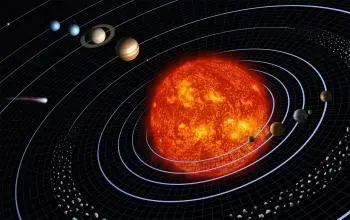
Kepler's laws are three principles formulated by the German astronomer Johannes Kepler in the 17th century that describe the motion of the planets around the Sun. These laws are fundamental to understanding celestial mechanics and laid the foundation for the development of orbital physics. .
Kepler's three laws are as follows:
-
Kepler's first law, law of orbits: The planets describe elliptical orbits around the Sun, where the Sun occupies one of the foci of the ellipse.
-
Kepler's second law, law of areas: The speed at which a planet moves along its orbit varies so that the radius vector joining the planet to the Sun sweeps out equal areas in equal times.
-
Kepler's third law, law of periods: The square of the orbital period of a planet is directly proportional to the cube of the length of the semimajor axis of its orbit. In other words, the time it takes for a planet to go around the Sun once (its orbital period) is related to the average size of its orbit.
These Kepler laws provided an accurate description of planetary motion and are considered fundamental to Isaac Newton's later development of the theory of universal gravitation.
Kepler's first law: law of orbits
Kepler's first law, also known as the law of orbits, states that the planets describe elliptical orbits around the Sun.
In an ellipse, the Sun occupies one of the two foci of the ellipse. This means that the path followed by a planet around the Sun is not a perfect circle, but an oval shape.
The ellipse has two special points: perihelion and aphelion. Perihelion is the point in the orbit where the planet is closest to the Sun, while aphelion is the farthest point.
Kepler's first law broke with the ancient belief that the planets moved in perfect circles around the Sun. It was a significant advance in our understanding of the solar system and laid the foundation for later understanding of gravity and orbital physics.
Kepler's second law: law of areas
Kepler's second law, known as the law of areas, states that a planet moves faster when it is closer to the Sun and slower when it is farther away. In other words, the radius vector that joins the planet to the Sun sweeps out equal areas in equal times.
Imagine a line that joins the center of the Sun with the center of the planet. As the planet moves along its elliptical orbit, this line traces out an area in the orbital plane. The law of areas states that the area covered by that line during a given period of time is constant.
Therefore, in its elliptical path, a planet covers equal areas in equal times, which implies that it spends more time in the farthest part of its orbit and less time in the part closest to the Sun.
Kepler's third law: law of periods
Kepler's third law, known as the law of periods, establishes a relationship between the orbital period of a planet and the average size of its orbit. It is a law that describes how the periods of revolution of the planets vary around the Sun.
Kepler's third law can be expressed as follows: the square of the orbital period of a planet is directly proportional to the cube of the length of the semimajor axis of its orbit. Mathematically, it is expressed as:
T 2 = k * r 3
Where
-
T is the orbital period of the planet.
-
r is the length of the semimajor axis of its orbit.
-
k is a constant that depends on the mass of the Sun.
In other words, the greater the average distance of a planet from the Sun, the greater its orbital period squared. This law establishes a proportional relationship between the size of the orbit and the time it takes a planet to go around the Sun completely.
Kepler's third law is important because it provides a way to compare the orbits and orbital periods of different planets. In addition, it serves as a basis for understanding and calculating the orbits of other objects in the solar system, such as moons and asteroids.